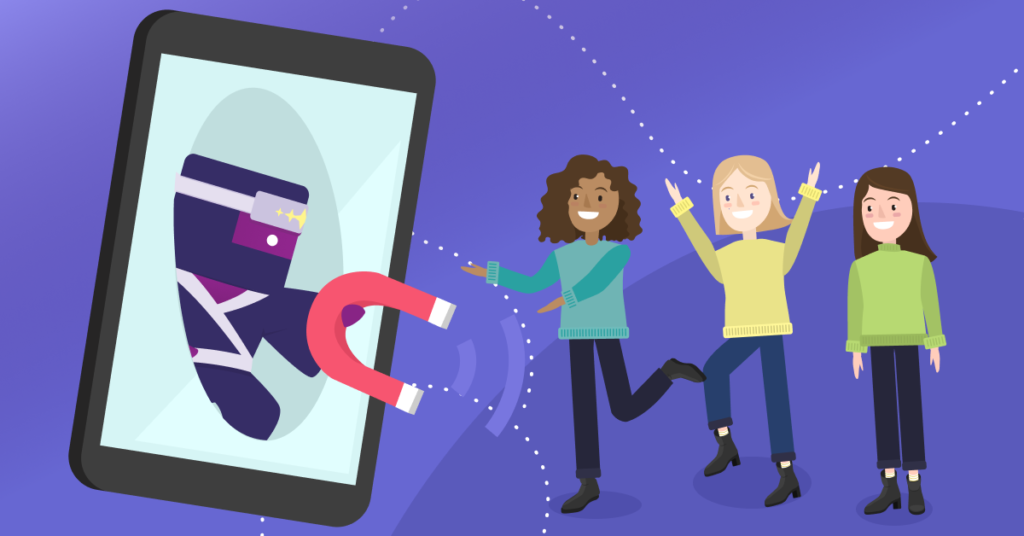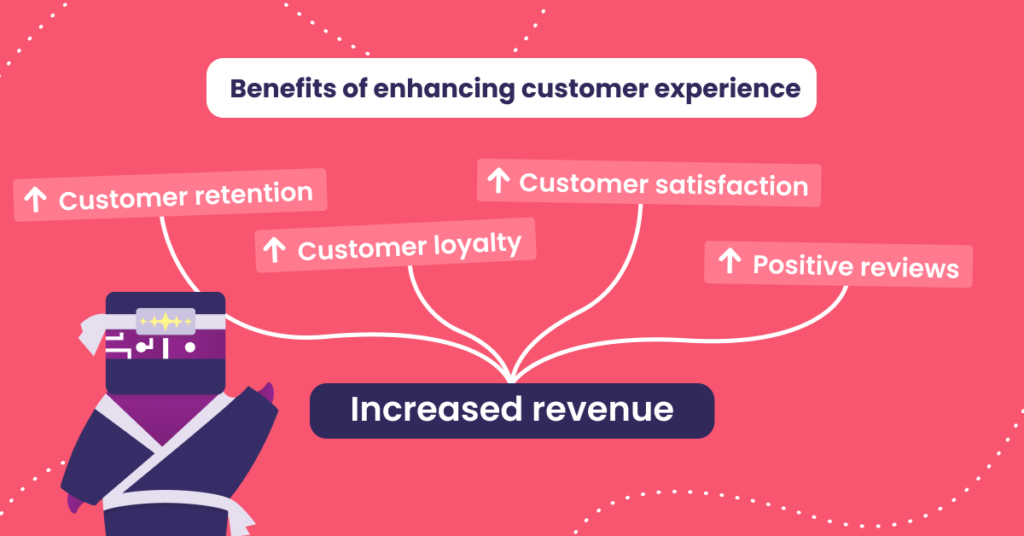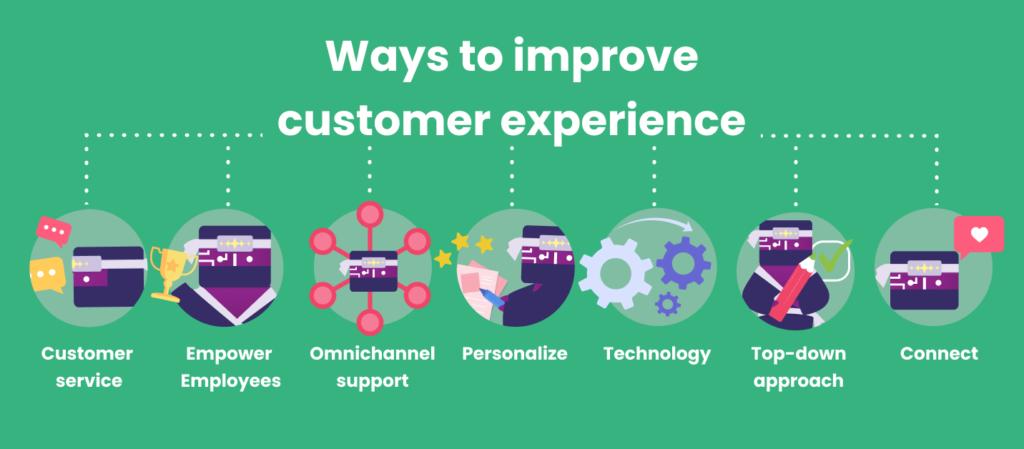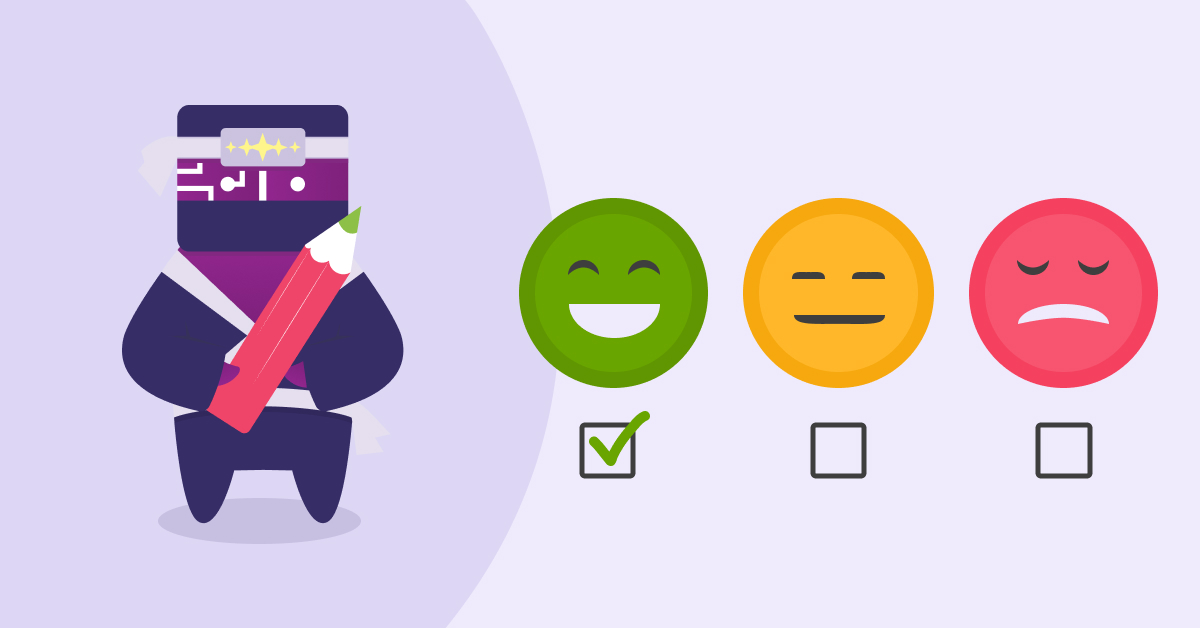Customer expectations keep rising, as do their demands. This is why enhancing the customer experience is critical to the success of your business. They expect excellence. Our challenge, then, is to keep up with their ever-changing behaviors, buying patterns, and needs.
It puts more pressure on businesses to balance the products and services they offer while their internal resources meet consumers’ demands. Customer-centric companies are reaping the rewards, yet, only 14% of companies measure the ROI of customer experience.
So how do you improve customer experience, and what exactly is it? Well, it is everything related to your business that affects a customer’s perception or feelings about your company. It’s not just the product they buy; it’s the entire journey — from pre-sales and sales to after-care. It is in every interaction they have with you.
What defines customer experience?
Customer experience is the customer’s journey with your brand and everything that shaped it.
You could think of it as starting a relationship, the flirting that indicates interest. The initial conversations form the foundations—the building of trust by providing information. And, if it all goes well, it ends in a mutually beneficial relationship where both parties get what they want.
Customer experience, therefore, focuses on building the relationship between a business and its customers. And as we all know, building and maintaining any significant relationship takes work. When you start to approach your customer journey the same way you would a relationship with a loved one, it is easier to assess where you can make improvements.
When it comes to your customers, it is important to make the distinction between customer experience and customer service. If you think of the customer experience as the relationship, then consider customer service as the marriage counselor. It’s where you turn to when things go wrong. When the relationship breaks down, it becomes your last-ditch effort to save it before it is too late and you lose that person forever. Improving the customer experience is about defining the expectations of both parties, and successfully delivering on them.
Attraction, retention, and customer experience improvement

Dating. You all remember how it feels to have a crush, don’t you? First, you notice that special something in a person. You get to know each other and bond over shared interests. Soon you’re going on dates, exchanging hopes and dreams. Your love interest is having the time of their life with you. All of a sudden you’ve fallen in love — a successful customer experience feels the same for your customers.
It starts with your approach, your brand, and the feelings it invokes. And it applies whether you’re meeting people online, in person, at a church, or in a bar.
While this is a familiar situation for most — we all know how easily things can go wrong. Today’s saturated market is like a crowded bar — to get noticed, you need to stand out either with your effective advertising, an innovative product, great customer service, and referrals, or all of them together. How you approach the customer, treat them, and make them feel makes the difference between customer experience success and failure.
But this is about attraction. What about retention? A wrong move can cost you the relationship with a customer. And we all know that attracting new customers is much more expensive than retaining the existing ones. What long-term experience your agents give to the customer is, therefore, definitive in whether they want to become a true blue fan of the brand. In other words, how your employees interact with your customers is paramount to their experience.
What is customer success?
Let’s keep this relationship metaphor going, shall we?
If the goal of dating is to get married, then your ultimate triumph is everything after your love says “I do.” Customer success starts the moment your customers make their final purchase.
Whereas customer service is reactive – the strategies you take to delight your customers and correct negative interactions – ensuring customer success is proactive. When the customer success team is deployed they act like marriage counselors. This team is also checking in with customers to make sure the delivery was successful. And after, they measure a customer’s satisfaction with the product, even asking for feedback for future improvements.
Customer experience teams and customer success teams typically work hand in hand. They have a common goal – to protect and continue their relationship with your company – but indeed, these are two different things.
Customer experience is qualitative. The data collected here tracks how customers feel about your products, support processes, and brand. This data is gathered in interviews, by looking at service interactions, or by following conversations on social media. Customer success, on the other hand, is quantitative – this is measured with tangible evidence, like metrics. Customer success metrics are pulled from insights like Churn Rate or Net Promoter Score.
Why customer experience is important to your business
Enhancing the customer experience is hugely important for any business. The better experience customers have, the better your customer retention, loyalty, and referrals. Not to mention reducing customer complaints and returns.

The benefits of enhancing customer experience include:
- increased customer loyalty and retention
- higher customer satisfaction
- more positive reviews and recommendations and better word-of-mouth marketing
And all of these lead to increased revenue.
The impact of negative customer experiences
Fail to meet your customer’s needs and they’ll struggle to let it go.
Customers want nothing more than to know they’ve made the right choice. They spend time researching your products, what others say about them, and comparing prices and functionality. So when they finally get the product but something goes wrong – it makes an impact.
Did you know 61% of customers have left a company to purchase from a competitor after having a bad customer experience? According to a Qualtrics report, all companies surveyed, across the 20 different industries, on average, lost 4% of revenue due to backlash after delivering bad customer experiences.
Not only does negative customer experience impact your company’s bottom line, but it also ruins your reputation. Customers want to be brand loyal. They want to form communities around shared interests and, naturally, products are a part of that. They trust each other and will listen when one of their own speaks up. So if you want to protect your good standing, you need to focus on achieving customer experience success.
Defining your customer
Enhancing your customer’s experience is a lot easier when you consider whose experience it is you want to improve.
Defining your customer sounds pretty straightforward — it’s the people who want to (and do) buy your products and services. And these types of customers are important because they drive revenues; without them, businesses cannot continue to exist. But a company without employees doesn’t exist either.
Sueanne Carr, a customer strategy expert, noted, “Customers are in charge of your destiny.” That they “possess the power to see a company prosper or fail.”
Increasingly, and quite rightly so, employers realize that there are two types of customers — internal and external. Internal customers are your employees — their experience with the company has a direct impact on your external customers — the people who get to enjoy your end product or service.
Those employers recognize that improving an employee’s overall experience determines their job satisfaction and performance. Better satisfaction results in them being a greater value to the company. And since employees are the lifeblood of your company they can propel you into the future.
Luckily, there are multiple similarities between internal (employees) and external customers.

Comparing internal and external customers
Money
Customers buy stuff to create revenue. Employees make and sell the products consumers buy. They also keep your operations moving effectively, thus creating revenue like your external customers.
Individuality
Both your customers and employees are individuals. They have different needs and wants. They want to be interacted with and understood at their level. Neither are droids, and their individuality makes them uniquely valuable.
Retention
It is estimated that the cost of getting a new customer is five to 10 times more than keeping an existing customer. Likewise, employee turnover can cost employers 33% of an employee’s annual salary. Nurturing loyalty is a powerful strategy to keep your business moving forward.
Referrals
Word-of-mouth has always effectively marketed your business, products, and services. Both customers can serve as advocates for your brand. Either by spreading the word about your company as a great place to work or telling their friends about the great products they bought.

Personalization
Customers expect to have a personalized interaction with your company. One-size-fits-all doesn’t work in people management, either. A brilliant CRM tool can help you with both and will allow you to not only track your customer’s interactions with you but also allow you to track your employee’s performance so you can provide personalized feedback and input into their performance and development.
Read more: Everything you need to know about customer service coaching
And for your business to be the best — you need to enhance the customer experience for both. The old adage, it seems, is true — it starts with you. If you treat your internal customers right, they will treat your external customers right. And that will automatically result in improving the customer experience.

Ways to improve customer experience
Positive customer experiences create loyal customers. Improving the external customer experience can lead to your customers becoming brand ambassadors, and increasing the likelihood of repeat business.
After purchase, a customer will usually only reach out when something has gone wrong. Before purchase, they will typically reach out so that you can help them decide on the purchase. Improving contact center customer processes and experiences will significantly impact your business. Below, we have a few tips to help you improve your overall customer experience, impacting both your internal and external customers.

Improve customer service
The more knowledgeable and helpful your employees are, the more they can help customers resolve problems. This is especially true if you have a call center or remote help desk — having a human being handle the work can make all the difference in a frustrating situation.
But it’s not enough to just give employees a script and tell them what they’re supposed to do when they take calls from customers; they need thorough and regular coaching guidance in how to handle the situations that arise most often, what questions customers will ask, and how you want them to respond so that you can monitor their performance and see when there’s improvement needed.
After all, with well-trained customer service teams, you can consistently increase customer satisfaction.
Read more: 7 simple strategies to improve your customer satisfaction (CSAT)
Empower employees
It’s an inside-out approach that starts with meeting the needs of your employees. Employees who are happy and empowered will take more responsibility for their role – they are more confident in their job and decision-making processes. You can empower your employees through training and coaching, but it is also important to hire right and manage employee expectations to improve their performance. When an empowered employee interacts with a customer they can take appropriate action without waiting for a manager’s approval, which in turn, improves the customer’s experience.
Read more: The science behind customer service motivation
Be available
It is important to meet your customers where they are. It makes it easier for them to both find, and interact with you. Different generations of customers have different needs and use different platforms to reach out to you. When you embrace an omnichannel approach in your customer service delivery and unite all conversations on one platform – you make it easier for your customers to reach out, to find the right solutions, and your service delivery is personalized to their communication preferences.
Read more: Top 5 chat metrics and ways to improve them
Make it personal
Customers have come to expect personalized experiences as the norm. That doesn’t mean they expect businesses to know every detail of their personal lives — they’re savvy enough to know companies aren’t that omniscient. But they do want to feel like you know them, their interactions with your brand, and that you care about them as individuals.
People love hearing that their issue is important to someone else, especially if they feel as though they’re being treated like a number or a transaction instead of a person. This goes back to making customers feel cared for and should be a focus from the start of your business. When you take steps to make customers feel valued and important, it improves the likelihood of loyalty and future purchases.
Leverage technology
Technology doesn’t just make employees more efficient; it also helps them add value to the customer experience. Using the right technology can help you build great customer service teams and provide better customer experiences, faster. Having a system that helps you understand what your customers need and how your agents are performing, will allow you to improve the customer experience quickly.
With technology, you can record calls, track customer satisfaction, and monitor any other data that might help you pinpoint areas of customer service that need improvement. Automation has also made major advances in the past few years. With the push for customer service providers to deliver data-driven performance management, automated reporting has introduced brilliant solutions for CS managers. With a single click, real-time insights are ready for you to talk to agents about their performance or give a report to the upper management.
Read more: How END. built their best support team ever
Have a top-down approach
A top-down approach to enhancing your customer’s experience requires a strategy. Leaders in customer experience at your enterprise should have a fully realized vision of what an ideal customer’s journey should look like.
This strategy, in turn, needs not only to be communicated to support teams but demonstrated across the workplace as well. Having a top-down approach to improving customer experience means that management leads by example. They set clear expectations for employees across all departments and provide regular feedback on individual performance. In order for CX improvements to have the impact you want, they should be made at the highest level of the business and rolled out across.
It’s important that every employee understands why excellent customer experience is important and knows what they’re expected to do in order to achieve this goal. But they always need an example to look up to.
Make a connection
Every relationship is built on connections. Whether it is your relationship with your employees or your customers — empathy is important.
It allows you to connect with your customers to improve their experiences. So whether you are providing your contact center customer service team with coaching and advice with regard to their performance – doing so with empathy will significantly improve their perception of the interaction and help you build a coaching culture.
Likewise, when they interact with external customers with empathy and understanding, they improve the customer’s experience – and form a deeper connection to your customers.
Communicate expectations and set clear goals
The demand for agents to have clear communication skills is undebatable. However, people at the management level – team leads and QA specialists – need to have these skills as well. It’s a simple and often-made mistake to overlook how poor communication hinders improvements to customer experience. In customer service, we focus a lot on our metrics, KPIs, and, of course, the customer. But when those numbers start to disappoint, how do you, as a leader, steer your agents down the right path?
There’s nothing more important than communication. To improve your customer’s experience, agents need to know why their performance is being reviewed, what your expectations are in the future and how to gain these skills appropriately.
Read More: 3 simple but effective tips for customer service managers
Look at every touchpoint
Even the negative ones.
Have you ever wondered what to do with your archive of negative feedback? Support teams that review their touchpoints know that customer experience is important. Despite the pressures of their job, leading service teams take time to look at trends in customer feedback and use the information to create a better experience that customers will enjoy.
As you review each touchpoint, agents and team leads alike can sit together and learn from their mistakes. These insights can also be archived to provide reusable resources that agents can refer back to when they need to sharpen their skills.
Read More: How to use negative customer feedback to improve customer satisfaction
Collaborate across teams
Customer service departments are at the frontlines of business operations. This type of real-time access to customers is a privilege that most other departments don’t get. Because of this, customer service departments hold an incredible amount of personal data. Of course, customer service teams have a responsibility to protect that data. But they should also consider adding “share customer insights” to the list of ways to improve customer experience!
So the next time a customer leaves a review about buggy products, forward it to the development team. Your customers will thank you in the end.
Read More: Customer happiness explained: what does it take to make a happy customer?
Final thoughts
Customer experience is a feeling. It’s a state of mind that comes from interacting with your business, whether it’s in person, on the phone, online, or through social media.
It’s also the first impression someone has of your company. So if you want to improve customer experience, you’ll need to be creative and willing to innovate.



